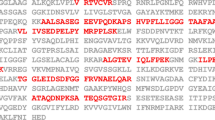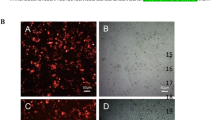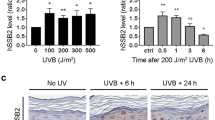Abstract
Human papillomaviruses (HPV) are causative agents of human cancers including those of the cervix and also of the head and neck; HPV16 is the most commonly found type in these diseases. The viral E2 protein regulates transcription from the viral genome by interacting with DNA-binding sequences in the HPV transcriptional control region; it also regulates replication by interacting with and recruiting the HPV replication factor E1 to the viral origin. Therefore, E2 is essential for the viral life cycle. The E2 protein interacts with several proteins involved in the cellular response to DNA damage including p53, TopBP1, and PARP. We therefore set out to establish whether DNA-damaging agents can regulate E2 activity. Here we show that UVB irradiation downregulates transcriptional activity of both HPV16 and HPV8 E2, while hydroxyurea and etoposide do not. This downregulation of E2 activity is independent of p53 function as it occurs in p53 wild type and null cell types as well as in the presence of functional HPV16 E6 that degrades p53. Using stable cell lines expressing E2 we show that this downregulation of E2 function by UVB is due to a reduction of the E2 protein half-life. The identification of the pathway(s) through which UVB downregulates E2 transcriptional activity and protein levels will present a novel target for the treatment of HPV-related diseases.
This is a preview of subscription content, access via your institution
Access options
Subscribe to this journal
Receive 50 print issues and online access
$259.00 per year
only $5.18 per issue
Buy this article
- Purchase on Springer Link
- Instant access to full article PDF
Prices may be subject to local taxes which are calculated during checkout






Similar content being viewed by others
References
Bellanger S, Demeret C, Goyat S and Thierry F . (2001). J. Virol., 75, 7244–7251.
Berg M and Stenlund A . (1997). J. Virol., 71, 3853–3863.
Beniston RG, Morgan IM, O'Brien V and Campo MS . (2001). Carcinogenesis, 22, 1069–1076.
Boner W, Taylor ER, Tsirimonaki E, Yamane K, Campo MS and Morgan IM . (2002). J. Biol. Chem., 277, 22297–22303.
Bouvard V, Storey A, Pim D and Banks L . (1994). EMBO J., 13, 5451–5459.
Breiding DE, Sverdrup F, Grossel MJ, Moscufo N, Boonchai W and Androphy EJ . (1997). Mol. Cell. Biol., 17, 7208–7219.
Chao SF, Rocque WJ, Daniel S, Czyzyk LE, Phelps WC and Alexander KA . (1999). Biochemistry, 38, 4586–4594.
Day PM, Roden RB, Lowy DR and Schiller JT . (1998). J. Virol., 12, 142–150.
Dell G and Gaston K . (2001). Cell Mol. Life Sci., 58, 1923–1942.
Desaintes C, Goyat S, Garbay S, Yaniv M and Thierry F . (1999). Oncogene, 18, 4538–4545.
Florenes VA, Maelandsmo GM, Forus A, Andreassen A, Myklebost O and Fodstad O . (1994). J. Natl. Cancer Inst., 86, 1297–1302.
Herceg Z and Wang ZQ . (2001). Mutat. Res., 477, 97–110.
Hibma MH, Raj K, Ely SJ, Stanley M and Crawford L . (1995). Eur. J. Biochem., 229, 517–525.
Kulms D and Schwarz T . (2002). J. Dermatol., 29, 189–196.
Lakin ND and Jackson SP . (1999). Oncogene, 18, 7644–7655.
Lee D, Kim JW, Kim K, Joe CO, Schreiber V, Menissier-De Murcia J and Choe J . (2002). Oncogene, 21, 5877–5885.
Lee D, Lee B, Kim J, Kim DW and Choe J . (2000). J. Biol. Chem., 275, 7045–7051.
Lepik D, Ilves I, Kristjuhan A, Maimets T and Ustav M . (1998). J. Virol., 72, 6822–6831.
Li N and Karin M . (1998). Proc. Natl. Acad. Sci. USA, 95, 13012–13017.
Mantovani F and Banks L . (1999). Semin. Cancer Biol., 9, 387–395.
Massimi P, Pim D, Bertoli C, Bouvard V and Banks L . (1999). Oncogene, 18, 7748–7754.
Midgley CA, Desterro JM, Saville MK, Howard S, Sparks A, Hay RT and Lane DP . (2000). Oncogene, 19, 2312–2323.
Munger K, Basile JR, Duensing S, Eichten A, Gonzalez SL, Grace M and Zacny VL . (2001). Oncogene, 20, 7888–7898.
Nghiem P, Park PK, Kim Ys YS, Desai BN and Schreiber SL . (2002). J. Biol. Chem., 277, 4428–4434.
Park YB, Park MJ, Kimura K, Shimizu K, Lee SH and Yokota J . (2002). Cancer Genet. Cytogenet., 133, 105–111.
Patel D, Huang SM, Baglia LA and McCance DJ . (1999). EMBO J., 18, 5061–5072.
Penrose KJ and McBride AA . (2000). J. Virol., 74, 6031–6038.
Perez P, Page A and Jorcano JL . (2000). Mol. Carcinogenesis, 27, 272–279.
Purdie KJ, Pennington J, Proby CM, Khalaf S, de Villiers EM, Leigh IM and Storey A . (1999). EMBO J., 18, 5359–5369.
Rank NM and Lambert PF . (1995). J. Virol., 69, 6323–6334.
Romanczuk H, Thierry F and Howley PM . (1990). J. Virol., 64, 2849–2859.
Ruhland A and de Villiers EM . (2001). Int. J. Cancer, 91, 828–834.
Sanders CM, Stem PL and Maitland NJ . (1995). Virology, 211, 418–433.
Schwarz E, Freese UK, Gissmann L, Mayer W, Roggenbuck B, Stremlau A and zur Hausen H . (1985). Nature, 314, 111–114.
Spruck CH and Strohmaier HM . (2002). Cell Cycle, 1, 250–254.
Steger G and Corbach S . (1997). J. Virol., 71, 50–58.
Steger G, Ham J, Lefebvre O and Yaniv M . (1995). EMBO J., 14, 329–340.
Strasswimmer J, Lorson CL, Breiding DE, Chen JJ, Le T, Burghes AH and Androphy EJ . (1999). Hum. Mol. Genet., 8, 1219–1226.
Stubenrauch F and Pfister H . (1994). J. Virol., 68, 6959–6966.
Tang D, Wu D, Hirao A, Lahti JM, Liu L, Mazza B, Kidd VJ, Mak TW and Ingram AJ . (2002). J. Biol. Chem., 277, 12710–12717.
Titolo S, Pelletier A, Sauve F, Brault K, Wardrop E, White PW, Amin A, Cordingley MG and Archambault J . (1999). J. Virol., 73, 5282–5293.
Vance KW, Campo MS and Morgan IM . (1999). J. Biol. Chem., 274, 27839–27844.
Vandel L and Kouzarides T . (1999). EMBO J., 18, 4280–4291.
Webster K, Parish J, Pandya M, Stern PL, Clarke AR and Gaston K . (2000). J. Biol. Chem., 275, 87–94.
Wells SI, Francis DA, Karpova AY, Dowhanick JJ, Benson JD and Howley PM . (2000). EMBO J., 19, 5762–5771.
Yamane K, Wu X and Chen J . (2002). Mol. Cell. Biol., 22, 555–566.
zur Hausen HJ . (2000). Natl. Cancer Inst., 92, 690–698.
Acknowledgements
We would like to thank Professors Saveria Campo and John Wyke for a critical reading of the manuscript, and Dr Merlyn Hibma for the TVG 261 antibody. We also thank the late Professor Pawel Fuchs who kindly provided us with the HPV8 E2 expression vectors. This work was supported by the Scottish Hospitals Endowment Research Trust, the Royal Society, and the Biotechnology and Biological Sciences Research Council.
Author information
Authors and Affiliations
Corresponding author
Rights and permissions
About this article
Cite this article
Taylor, E., Boner, W., Dornan, E. et al. UVB irradiation reduces the half-life and transactivation potential of the human papillomavirus 16 E2 protein. Oncogene 22, 4469–4477 (2003). https://doi.org/10.1038/sj.onc.1206746
Received:
Revised:
Published:
Issue Date:
DOI: https://doi.org/10.1038/sj.onc.1206746



